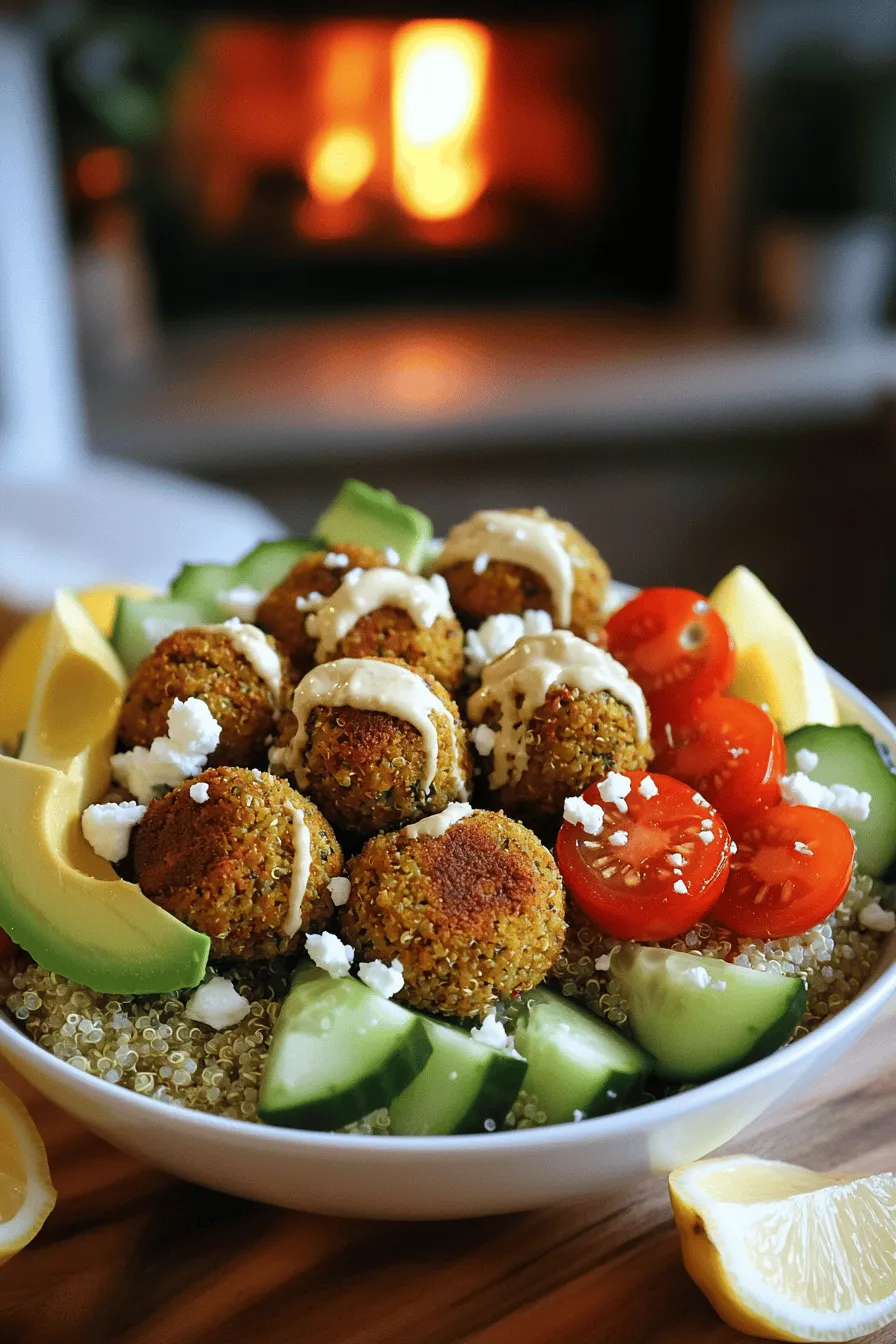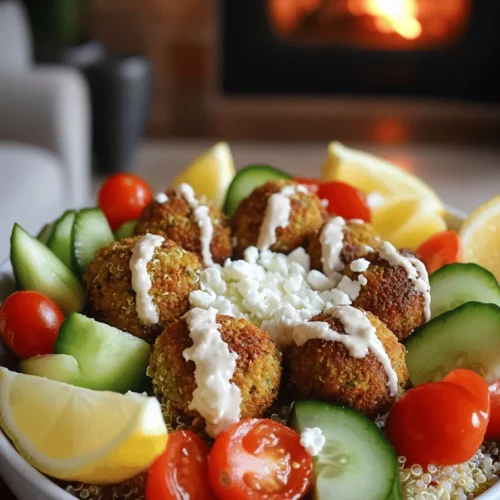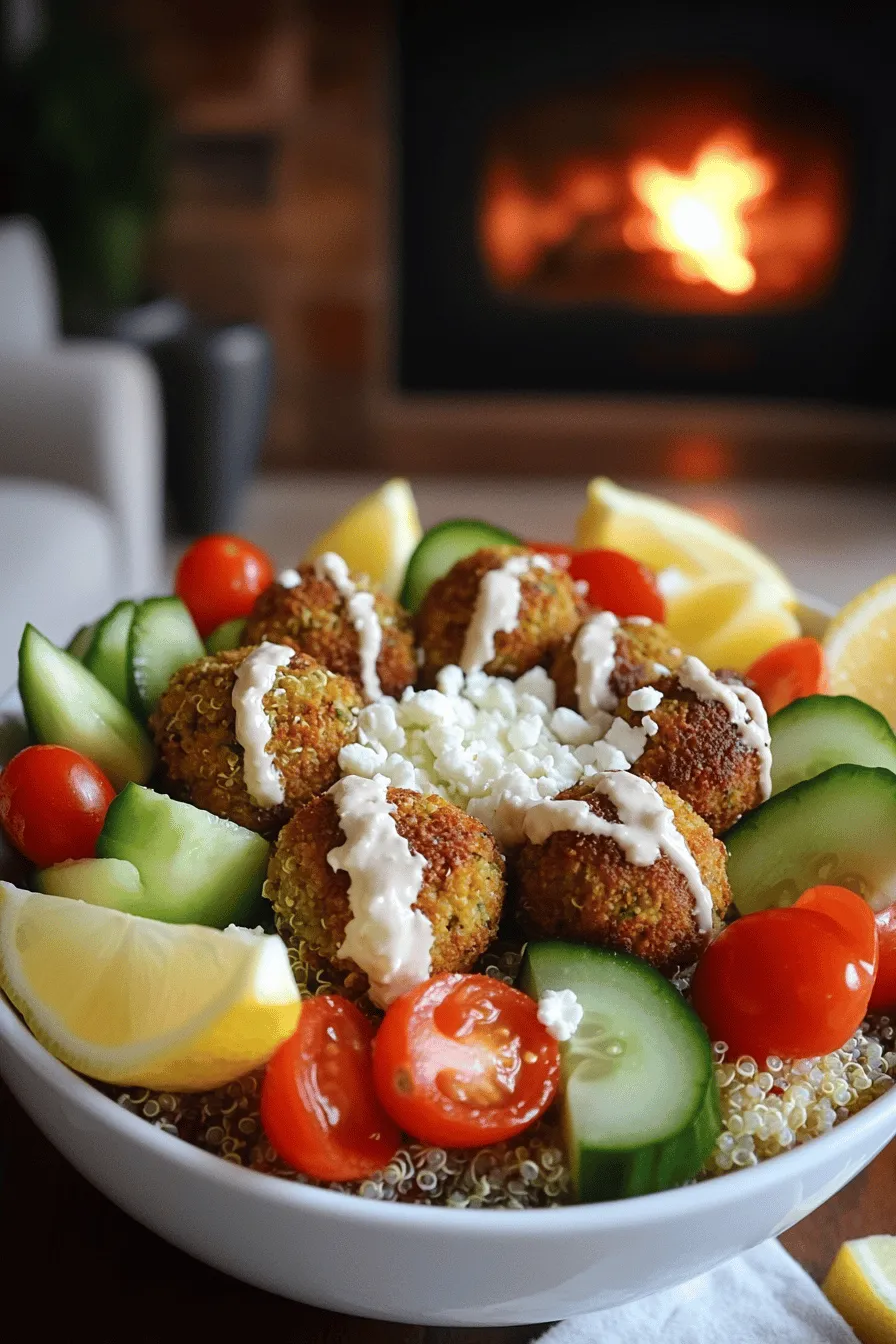Are you ready to create a falafel bowl that’s both easy and bursting with flavor? This guide will take you through each step, from selecting the best ingredients to perfecting your assembly. With tips on customizing for dietary needs, adding nutrition, and even exploring exciting variations, you’ll learn how to make this dish your own. Let’s dive into the tasty world of falafel bowls and get cooking!
What Ingredients Are Essential for a Delicious Falafel Bowl?
To make a great falafel bowl, start with the right ingredients. The main components include dried chickpeas, onion, garlic, and fresh herbs like parsley and cilantro. These ingredients give falafel its unique flavor. The spices, like cumin and coriander, add warmth and depth. Baking powder helps the falafel puff up when you fry them.
For a healthy falafel bowl, use whole grains as a base. Quinoa or couscous works well. Cherry tomatoes and cucumbers add freshness and crunch. Avocado gives a creamy texture and healthy fats. If you enjoy cheese, crumbled feta is a tasty option.
You can customize your falafel bowl based on your preferences. If you want a vegan falafel bowl, skip the feta. You might add grilled veggies or roasted sweet potatoes instead. If you’re gluten-free, use quinoa or omit the grains altogether.
Choosing healthy ingredients matters. Fresh veggies provide vitamins and fiber. Whole grains have more nutrients than processed options. Avoid frying if you want a lighter meal. Instead, bake the falafel for a crispy texture without added oil.
This recipe is all about balance. You get protein from chickpeas and healthy fats from avocado. Use the Full Recipe to create your own delicious falafel bowl!
How Can You Prepare a Perfect Falafel Bowl?
What Are the Steps for Making Homemade Falafel?
To make homemade falafel, you start with dried chickpeas. Soak them overnight in water. This softens them and makes them easier to blend. Then, in a food processor, mix the soaked chickpeas with a small chopped onion, minced garlic, fresh parsley, and cilantro. Add ground cumin, ground coriander, baking powder, salt, and pepper. Pulse the mixture until it forms a dough. Remember not to over-process; you want some texture. Next, shape the dough into small balls. Place them on a baking sheet lined with parchment paper.
How Do You Assemble the Bowl for Maximum Flavor?
To assemble the bowl, first layer cooked quinoa or couscous as the base. This gives the bowl a hearty feel. Next, add fresh halved cherry tomatoes, diced cucumber, and sliced avocado on top. The bright colors and flavors make the bowl pop. Finally, place 3-4 falafel balls on the mixture. This adds protein and crunch. Drizzle tahini sauce over the top for creaminess. If you like, add crumbled feta cheese for a salty bite. Serve with lemon wedges on the side for a refreshing zing.
Are There Quick Tips for Perfecting the Cooking Process?
When frying falafel, heat oil in a deep pan over medium heat. Fry the falafel in small batches to keep the temperature steady. Each side should take about 3-4 minutes until golden brown. Drain them on paper towels to get rid of extra oil. If you want to bake them, preheat your oven to 375°F (190°C) and bake for about 20 minutes, flipping halfway. This makes them a bit healthier. Enjoy the vibrant flavors of your easy falafel bowl recipe! You can find the full recipe above.

What Are the Best Toppings for Your Falafel Bowl?
Falafel bowls are fun and easy to make. Toppings add flavor and crunch. Here are some ideas for toppings that work great with your falafel bowl.
What Are Some Classic Toppings to Enhance Taste and Texture?
Some classic toppings for your falafel bowl include diced tomatoes, cucumbers, and fresh herbs. These add freshness and color. You can also add pickled red onions for a tangy kick. Another tasty option is crumbled feta cheese, which gives a creamy texture. For a bit of heat, try adding sliced jalapeños. These toppings will enhance taste and make your bowl pop!
How Can You Create Unique Combinations with Different Ingredients?
To create unique combinations, mix and match toppings based on your mood. Try using roasted vegetables like bell peppers and zucchini. These add a warm, hearty flavor. You could also use grains like farro or barley instead of quinoa. Adding nuts, like toasted almonds or sunflower seeds, can bring a nice crunch. Lastly, drizzling different sauces, like spicy harissa or yogurt sauce, can change the entire flavor profile.
What Are Some Seasonal Toppings to Consider for Your Bowl?
Seasonal toppings can make your falafel bowl extra special. In summer, use fresh corn, sliced avocados, and juicy peaches. In fall, roasted pumpkin or butternut squash pairs well. Winter calls for toppings like brussels sprouts and pomegranate seeds, which add a festive touch. For spring, think about fresh peas and asparagus. Each season brings new flavors to enjoy!
These toppings not only enhance your falafel bowl but also make it fun to eat. You can find the full recipe to get started on your falafel bowl adventure!
How Do You Add Nutrition to Your Falafel Bowl?
Falafel bowls can be both tasty and nutritious. To boost the nutrition of your falafel bowl, focus on the ingredients.
How Does the Nutritional Value of Falafel Affect the Dish?
Falafel mainly uses chickpeas. Chickpeas are high in protein and fiber. This makes falafel a filling choice. The herbs and spices add vitamins and minerals too. You can add fresh veggies to your bowl. Cherry tomatoes and cucumbers provide vitamins and water. Avocado adds healthy fats.
What Are Caloric Considerations for a Balanced Meal?
A falafel bowl can range from 500 to 700 calories. The key is balance. Use quinoa or couscous as your base. These grains add energy and fiber. The falafel itself has calories from frying. Using less oil can cut down on calories. Consider serving size too. Three to four falafel balls is a good amount for one bowl.
How Can You Meal Prep a Healthy Falafel Bowl?
Meal prepping helps save time and ensures healthy meals. Start by making the falafel ahead of time. You can freeze uncooked falafel balls. When ready, just fry them fresh. Cook quinoa or couscous in bulk too. Store it in the fridge. Chop your veggies and keep them ready. This way, you can assemble your bowl quickly. For the full recipe, check out the complete guide. Enjoy your healthy falafel bowls all week long!

What Are Some Creative Variations of the Traditional Falafel Bowl?
Falafel bowls offer a fun way to enjoy this classic dish. You can create many tasty variations to suit your taste or dietary needs. Here are some ideas to get you started.
How Can You Modify the Recipe for a Mediterranean Twist?
To give your falafel bowl a Mediterranean twist, add fresh ingredients and spices. Use a base of couscous instead of quinoa. Add roasted red peppers and artichokes for extra flavor. You can also mix in olives for a salty kick. A sprinkle of za’atar spice blend can bring the whole dish together. This will create a vibrant and colorful meal full of taste.
What Makes a Gluten-Free Falafel Bowl Different from Traditional Versions?
A gluten-free falafel bowl swaps out any gluten-containing ingredients. Use quinoa or rice as your base. Ensure that your tahini sauce is also gluten-free. Most falafel is already gluten-free since it uses chickpeas. Just be careful with any added ingredients, like sauces or toppings. This way, everyone can enjoy a delicious bowl without gluten.
How to Incorporate International Flavor Profiles into Your Falafel Bowl?
You can add international flair to your falafel bowl with different spices and dressings. For a Thai twist, use coconut milk and lime juice in your dressing. Add chopped peanuts and cilantro for crunch. For a Mexican version, mix in black beans, corn, and salsa. Top it off with sliced jalapeños for some heat. These creative changes will keep your falafel bowl exciting and full of flavor.
For a complete guide on making falafel, check out the Full Recipe.
Where Can You Find the Best Falafel Bowls?
Finding the best falafel bowls can be a fun adventure. You have many options, from local restaurants to food trucks. Each place has its own unique take on this tasty dish.
What Are the Top Restaurants Known for Their Falafel Bowls?
Some restaurants stand out for their falafel bowls. Look for places that use fresh ingredients. A good falafel bowl has crispy falafel, colorful veggies, and tasty sauces. Reviews can help you find the best spots. Many food lovers share their experiences online. Check sites like Yelp or Google for ratings. You can also ask friends for recommendations. They might know hidden gems near you.
How Can Food Trucks Elevate Your Falafel Bowl Experience?
Food trucks offer a special vibe and unique flavors. They often serve fresh, quick meals. Many food trucks focus on quality and creativity. You might find interesting toppings or sauces that you won’t see in restaurants. A food truck can be a great way to enjoy a falafel bowl on the go. Remember to check their hours and locations, as they can change often.
What Should You Look for in a Restaurant’s Falafel Bowl Offering?
When choosing a falafel bowl, look for a few key things. First, check the ingredients. Freshness matters! If the veggies look bright and crisp, you’re on the right track. Second, taste the falafel. It should be crunchy on the outside and soft inside. Finally, consider the sauces. A good tahini sauce can bring everything together. If you see a full menu with many options, that’s a plus. It shows the restaurant cares about their dishes.
For a taste of falafel at home, try the Full Recipe for a delicious meal!
This blog post covered how to create a delicious falafel bowl. We explored key ingredients, preparation steps, and tasty toppings. You can customize your bowl for different diets and boost nutrition. Remember, variations can add fun and global flavors.
Incorporate what you love to make your falafel bowl unique. Enjoy experimenting with ingredients and flavors. Now it’s time to create your perfect bowl and share it with friends. Happy cooking!







